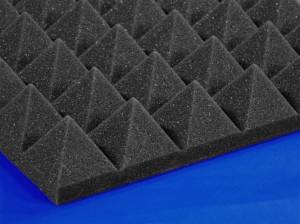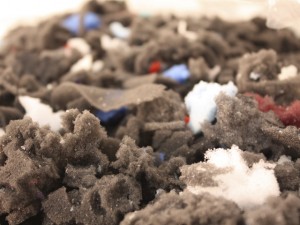One of the first things people should take into consideration when planning a space for optimum sound, whether it’s for movies, music, or recording, is sound treatment. As a useful acoustical treatment tool, sound deadening foam is one material people rely on for fixing flutter echoes, standing waves, and mid and high-frequency issues. But given the similarities between foam’s different varieties, many people wonder what the difference is between acoustical foam and the stuff in their couches and pillows.

At Foam Factory, Inc., we consider this an important question, because understanding the differences in materials, no matter how minor, can make finding the right product for the job much easier, acoustical or not. And with a product line that stretches from memory foam mattresses, pillows, and camping pads, to packaging solutions and sound deadening materials, Foam Factory is more than qualified to provide a distinction.
The truth is, while looking and feeling similar to other materials, acoustical foam is a specially engineered product with unique traits that differentiate it from the foam in your couch. Take a look at some of the differences between conventional and acoustical foam, and you’ll see why close enough isn’t good enough when it comes to sound treatment.
Fire Retardancy – While it doesn’t impact the sonic performance of foam, fire retardancy may be the single most important trait of acoustical foam due to safety. Because of ignition potential due to human activities like smoking and candles, as well as wiring and electronics, proper acoustical foam should have an acceptable fire retardancy rating, which conventional foam may lack. The testing method for foam fire retardancy is ASTM E84 and all Foam Factory open-cell acoustical foam has the highest ASTM E84 Class A safety rating.*
(For more information about ASTM E84, fire retardant foam, and Foam Factory’s Class A ratings, see our data sheets and article on the standard.)
Durability – Since acoustical treatment is susceptible to damage from human accidents, be it bumping into wedge foam tiles or dropping something heavy on a corner bass trap, it must be durable as well. Acoustical foam is made to be “non-dusting,” so it resists crumbling as the phrase implies. If used within a construction setup this wouldn’t be an issue, but in open spaces like studios or entertainment rooms packed with people, foam can be bumped, brushed, poked, and scratched. Foam Factory’s acoustic foam is made to stand up to this kind of infrequent, accidental wear longer than conventional foam used in the same way.
Firmness – Firmness, or Indentation Load Deflection (ILD), is an important characteristic for people selecting foam packaging or a couch cushion, but it also matters for sound foam. Acoustical foam is made to a firmness that offers the best absorption across all frequencies, as greater ILDs (firmer foam) absorb more low-frequency sound, and lower ILDs (softer foam) absorb more high-frequency sound. For a product like Foam Factory’s 3” pyramid tiles, a balance between the two must be used to cover the widest spectrum of performance. Using non-acoustical foam with unknown firmness values can leave voids or be too reflective.

Cellular Structure – A distinct physical difference between acoustical foam treatment and conventional foam is also present in the manufacture of the materials. Foam is made of many tiny cells, and the size of a cell has a meaningful impact on performance in all applications. Pores Per Inch rating (PPI) is one way foam is measured, and it means exactly what it sounds like: the number of individual cells in one linear inch of the foam. Comfort foam has a PPI of 60-70 cells and some porous materials have ratings low as 25 or 30 PPI. Good acoustical foam possesses a PPI around 80. A higher PPI means more cells, which translates to a more sonically absorbent product. For an example of what a difference PPI value can make, a 12” x 12” x 3” tile of 80 PPI foam would have about 127 million more cells than a 60 PPI foam with the same dimensions.
Appearance – While it sounds superficial, the appearance of acoustical foam is yet another difference between it and conventional materials. Minor blemishes within a couch cushion have no impact on its performance but would certainly be an aesthetic issue in an eggcrate diffusor or acoustical panels mounted in a professional studio. Because spaces are frequently works in progress, more materials may be needed down the road. Consistency is important because if you buy the same product months apart, the old and new need to look identical. Foam Factory’s designer patterns like spirals, waves, and grids also impact sound differently than plain sheet foam.
To the average person, it may seem that all foam is the same. In truth, the different types of foam are like apples and oranges; both fruit but different flavors. So if you need sound treatment, be sure not to pick a bad apple.
*Many areas have regulations involving the use of flame retardant materials, particularly in commercial situations, so check with your local code enforcement agencies before beginning a project.


I’d like to ask the different prices of acoustic foams, is it per tile, or by pack of 12s,or pack of 24s? How much is the 60 PPI & 80 PPI pyramid shaped?
How much is the egg crate shape 60 PPI and 80 PPI?
Does the pricing include freight and delivery? Or, please specify how much is the freight and delivery cost?
We sell the acoustic foam in packs. Shipping is included to the contiguous US for orders over $75. Please see our acoustic foam product pages for more information and pricing.
I want to cover a large window to block loud music of neighbor. what foam would be the most effective to block out bass/
What is suggested is closed cell foam, 1 to 2 inches of Neoprene-HQ foam Neoprene-HQ foam Neoprene-HQ foam.